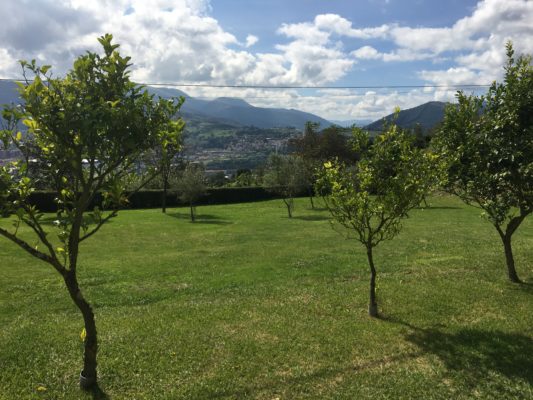See Travel 2017: Itinerary and Arrival for a rationale of this trip and an itinerary.
Monday, September 25/17. Margaret and I were up early, energised by a good if short sleep, and made it to Chamartín Train Station with plenty of time. After passing through security and clambering aboard with our luggage, we were soon on our way. The distance from Madrid to Bilbao is only 323 kilometres (201 miles) as the crow flies, but the train meanders for 5 hours via Segovia, Valladolid and Burgos.
Chamartín Station is towards the northern edge of Madrid, so we were soon out of the city and wending our way through the picturesque Guadarrama Mountains towards Segovia. Beyond Segovia, however, the landscape changed dramatically as we entered the northern half of Spain’s Meseta. This high central plateau ranges from 400 to 1000 metres (1,312 to 3,280 feet) high and covers large areas of Castile-León, Castile-La Mancha, Extremadura, and chunks of Aragón and La Rioja. It’s a flat, dry, windswept and harsh expanse extremely cold in the winter and burning hot in the summer. Nevertheless, farmers have turned this difficult land into an important growing area (mainly wheat), and flocks of sheep have historically criss-crossed its hedge less sweep.
Clusters of holm oaks (i.e. evergreen oak trees) and the occasional bluff broke the monotony of the yellow-brown landscape, and the distant outline of church towers dominating earth-coloured villages were reminders of the enormous influence of the Catholic Church in Spain’s history. Nowadays, the church towers often compete with modern secular newcomers: grain silos attesting to the importance of grain to the region’s economy.
After short stops at Valladolid (briefly Spain’s capital Spain’s 1601-1606) and Burgos (ancient capital of Castile and home to Spain’s first Gothic cathedral), the landscape began to change and in the distance outlines of mountains began to emerge. Soon after crossing the River Ebro at Miranda de Ebro we were skirting the tree-lined mountains of the eastern reaches of the Sierra Cantábrica. Here our train cut through passes and edged above green valleys dotted with neatly painted villages and well-maintained farms. We were now in Basque territory.
Our train rolled on time into Bilbao’s Abando Station, in the centre of the city, on time. Train stations are frequently ornate or powerful structures, a gateway to a city, and meant to immediately impress visitors. This was particularly so before the arrival of airports, which in many cases have now taken over this role (Bilbao’s airport, designed by one of Spain’s leading architects, Santiago Calatrava) is an example. See https://www.theguardian.com/culture/2000/nov/20/artsfeatures ).
Travellers arriving at Abando Station can’t miss a large, beautiful stained glass window that fills the entire wall overlooking the entry to the lobby from the platforms. Installed in 1948, the window pays homage to the city’s industrial history, its rural surroundings and activities associated with it (e.g. fishing, farming, rowing, jai alai players holding their cestas (long wicker racquets), the old bridge over the River Nervión (on which Bilbao is situated), and the early 16th century church of San Anton (St. Anthony). Both the church and the bridge feature in Bilbao’s coat of arms –the church has always been strong in conservative Basque society.

Outside the station, we took a taxi (fare 9 euros) to Hotel Artetxe, located high on a hill with a great view of the city.

It’s a small, intimate lodging, more like a B and B, and excellent value. By North American standards, our room (105) was small, but it was immaculate and tastefully furnished, and the beds were firm and comfortable.
With a population of about 350,000, Bilbao is the largest city in the Basque Country and is its economic hub. It stretches along both sides of the River Nervión valley and is overlooked by vivid green hills. It’s refreshing to see that development has not crept up the hills; indeed, one of the pleasures of walking in the city is that the hills are never far from sight.
Still feeling somewhat tired after our transatlantic overnight flight, we decided against going back down to the city. Besides, it was now fairly late, and a meal seemed more in order. There are two Basque restaurants close to the hotel, one alongside (Asador –i.e. Grill—Artetxe) and the other across the road (Asador Berriz Txakoli). The choice was made for us. The Asador Berriz Txakoli was closed, so it was the Artetxe (despite the similarity of names, this Asador has nothing to do with the hotel). The dining room was cozy with patterned tablecloths and matching serviettes. The meal was tasty, but compared to meals over the next three weeks, it was overpriced (euros92: $142). It consisted of garbanzo soup with lobster (much more shell than meat, unfortunately), cogote de merluza (hake cheeks, the choicest part of the neck of the fish), accompanied by a lovely bottle of Txakoli wine, a slightly effervescent white still relatively unknown beyond the Basque Country’s borders.
By the time we had eaten, we were ready for bed. It didn’t take long to get to sleep.

